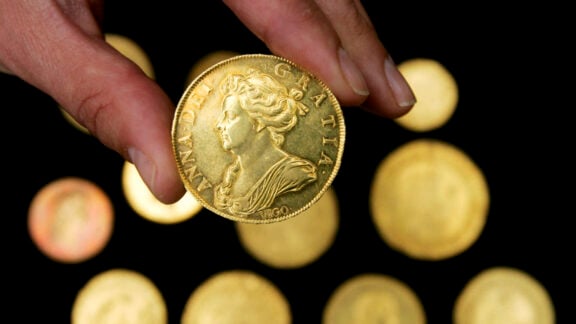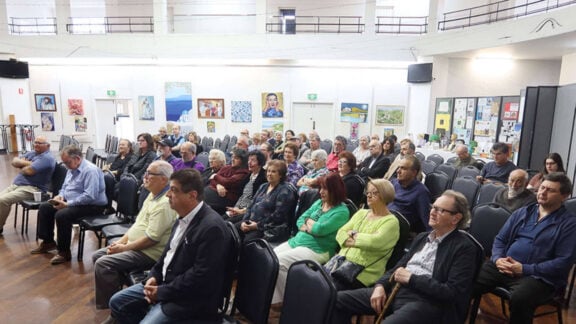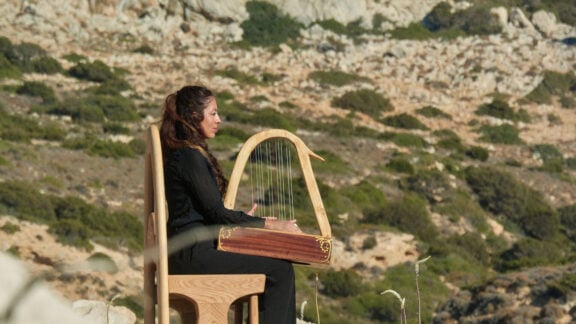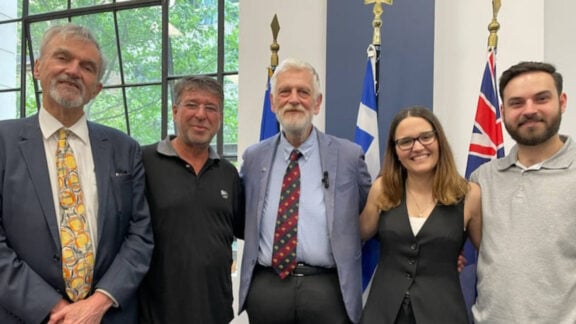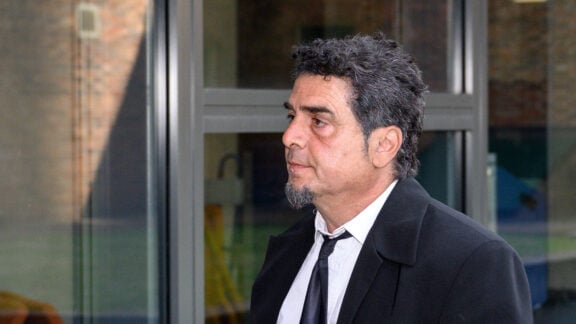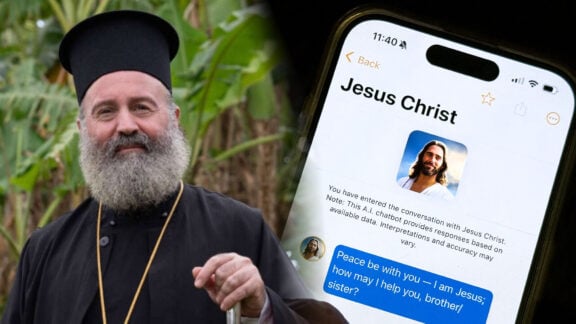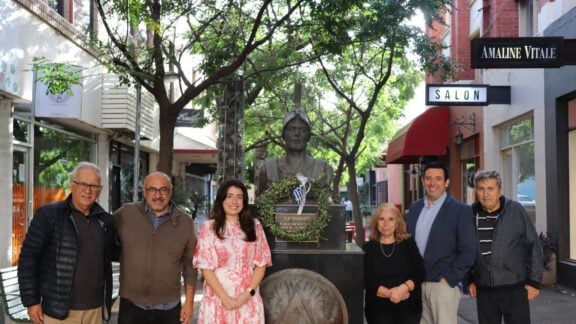Last weekend witnessed hundreds of people attend a series of commemorative events in Canberra and Sydney. The events saw the screening of the Lemnos Gallipoli Commemorative Committee’s new documentary on the Anzacs in the 1941 Greek campaign – Anzac The Greek Chapter – at Canberra’s prestigious Hellenic Club and Leichhardt’s Palace Cinema, a venue with strong links to Sydney’s Greek community.
Sydney honours Battle of Vevi and the Greek Campaign
The Sydney screening was organised and funded by the Pan-Macedonian Association of NSW to complement their annual commemoration of the battle of Vevi held at the art deco Anzac Memorial in Sydney’s Hyde Park. It was my privilege to be invited to deliver the presentation to this year’s commemoration.
The battle was fought around the little village of Vevi in northern Greece over three days in early April 1941 was the opening engagement for the Anzacs in Greece as they sought to confront the Nazi invasion. The battle saw Anzacs serve alongside British troops and their Greek allies against Hitler’s SS troops and overwhelming military odds, holding up the enemy advance at great cost. This was the first battle between Australian and German troops since 1918.

I have written about this battle and its significance to the Greek campaign and Australia’s Anzac story for many years. I have walked the ground of the battle on a number of occasions, visited the memorials erected to it in the region-and attended commemorative events held there by the local Greek authorities and Hellenic Armed forces.
The service of those who fought at Vevi deserves to be better remembered and the Pan Macedonian Association of NSW deserves to be congratulated for their efforts to do so through their annual commemoration – the only such commemoration in Australia.

Over a hundred people attended the service inside the Anzac Memorial, including many dignitaries such as the Consul of the Hellenic Republic in Sydney Yannis Mallikourtis. With leading SBS journalist Efthymios Kallos as master of ceremonies, the service included an address by the Consul and my keynote address followed by the laying of wreaths. It was a very solemn event conducted by the Association.
This event had been preceded the previous night by the screening of our Anzac documentary to a sell-out crowd. The engaged audience were audibly moved by the Australian veteran testimonies that are a feature of the film, especially their expressions of appreciation for the warm support they received from brave Greek civilians during the campaign. There were more than a few damp eyes in the audience.

One of those in attendance was SBS‘s Efthymios Kallos. “The film is such an impressive documentary, providing audiences with a vivid experience of the emotional depth of this important connection between Australia and Greece, a bond of blood, during this terrible time of war. I highly recommend the film”, Mr Kallos said.

Following the screening and presentation I was engaged by many of the audience eager to express both their appreciation for the film but also to share their own family connections to these events. Soon these conversations were taking me back to Vevi and Kalamata, to Corinth and Lemnos, to Kardamyli, the Mani and Crete. It was heartening to find an eager audience for my various relevant publications on the Anzacs-Hellenic connection.

The Association’s Peter Papoulidis regaled me with his own researches into the battle of Vevi, a village and region with family connections for him. He too has walked the ground of the battle, finding local witnesses to these terrible events and conducting tours of the area. It’s so heartening to listen to his enthusiasm for building awareness of this often overlooked part of history.

The evening was followed by a sumptuous celebratory dinner at one of Leichardt’s famous Greek restaurants, Koukouli. Great hospitality, music and parea soon had tongues wagging again, with Association members sharing their own stories of Kardamyli, Corinth and Thessaloniki. I’ve certainly made a few more friendships and colleagues on this commemorative trail.

I talked with Mr Spiro Georgiou, a proud Corinthian, about the battle of Corinth Canal, a key engagement of the 1941 campaign which not only saw Australian troops desperately defend the bridge but also the first mass use of paratroops by the Germans in the campaign. The learning’s from this battle were recorded by Australians who took part and passed on to the Allied command, no doubt of assistance in the later battle of Crete. We also discussed my work on the recent installation of the new commemorative plaque to the battle and the impending plaque to be installed at the location of the former POW camp established by the Germans further south.

Canberra commemorates the Greek Campaign, Imbros and Kritha
The Canberra commemorative event at the Hellenic Club in Woden was held on the preceding Friday and combined the Imbros & Gallipoli pictorial exhibition which I curated for Melbourne’s Imvrians’ Society with the documentary screening. The Society’s George Xinos, who worked with me on the exhibition project, was in attendance.
The Club’s Lisa Andoranos organized the event, with the film screened in the Club’s Apollo Room, with the 20 exhibition panels displayed on the surrounding walls. The whole effect was to reinforce the Hellenic connection of Australia’s Anzac story across both world wars. Lisa informed me that the exhibition had been displayed for a few days before the screening with many of the Club’s visitors coming to the Apollo Room to view and take in the impressive display.
Many dignitaries, community representatives and veterans families attended the event. Led by the Ambassador of the Hellenic Republic to Australia Stavros Venizelos and his wife, these included senior representatives of the Hellenic Club along with those from the local Cypriot, Cretan and Lemnian communities. The Australian Defence Force was represented by Captain Gary Zervas from the Australian Navy. Many members of the Krythian Association of Melbourne were also present.

The event commenced with an introduction by the President of Canberra’s Greek Orthodox community John Loukadellis as master of ceremonies. A long time supporter of Hellenic Anzac commemorations, with a number of strong connections to local Greek campaign veterans and their families, John expressed pride that the screening in Australia’s capital would be followed by its screening in Athens later this month. The Ambassador, who has connections to Mani which features both in the film and my own history of the campaign, then spoke in praise of the film and exhibition.

Many in the audience were moved by the veteran testimony in the film, some moved to tears by the raw emotion shared by these young men and women. Following the screening a number of Greek campaign veteran’s families in the audience shared their own family stories and thanked the producers for their work. Many viewed the impressive reproduction of photographs from Imbros in 1916, drawing attention to the intimacy of the interaction between the locals and the Allied service personnel, reflecting this earlier manifestation of common feeling so vividly communicated in the film of the 1941 campaign. After the film, Captain Gary Zervas expressed the desire to take part in a future Lemnos Gallipoli Memorial commemoration in Melbourne’s Albert Park.

Kris Stamboulidis of the Krithian Association spoke for many in attendance when she stated that she felt the combination of Imbros and Gallipoli with the story of the 1941 Greek campaign clearly brought an understanding of the Hellenic link to Anzac no more so than in its often overlooked aspects, such as Imbros.
The whole experience was complemented by a commemorative service conducted by the Krithian Association at Canberra’s Australian Hellenic Memorial. This impressive memorial stands in the shadow of the great Australian War Memorial.

This memorial is a unique combination of features – from its amphitheatre setting, the twisted girders representing war and destruction and the sliced through stone Greek style column signifying lives cut short, all erected on a mosaic representing the Greek mainland, islands and mountains. George Xinos and myself couldn’t help but notice the inclusion of Lemnos in the ground mosaic. I also liked finding the Mani and Kalamata, where in a few weeks not only will our film be screened but new Greek campaign commemorative plaques installed.
The assembly gathered for a brief presentation by Kris Stamboulidis, a wreath-laying by Stella Polychronopoulos and the singing of the Greek national anthem. A fitting tribute to those who served in the 1941 Greek campaign by this community whose forebears were so tragically impacted by war over one hundred years ago.

The holding of these events, the enthusiasm of the organizers and the participation of many members of the Hellenic abs wide community in the events not only commemorates these important parts of our common history but ensures the endurance of these feelings of shared experience and common humanity into the future. Congratulations to all who helped put these remarkable events together.
*Jim Claven OAM is a trained historian, freelance writer and published author. His many publications include Lemnos & Gallipoli Revealed, Grecian Adventure, From Imbros Over The Sea and Mates and Allies (the latter as a contributor). He thanks John Loukadellis and Canberra’s Hellenic Club as well as Patricia, Anastasia and the Pan Macedonian Association of NSW for their support of these events. He also thanks Nick Andriotakis of the Battle of Greece & Crete Committee for his informative tour of the Anzac Memorial in Sydney. He can be contacted via email – jjmclaven@yahoo.com.au


